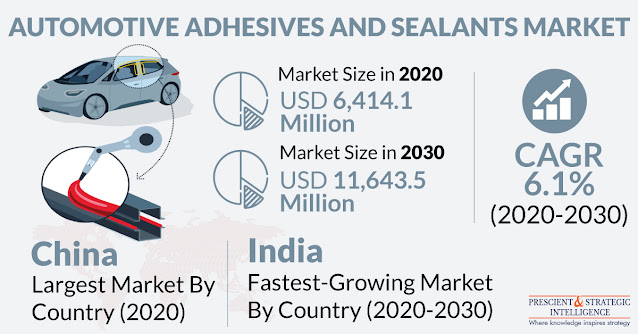Automotive adhesives and sealants are used in a wide range of applications, from small sensors to big vehicle frames. To keep the vehicle's weight down, many high-performance automobiles are made of lightweight composite materials. Because these composite materials cannot be welded, mechanical fasteners must be used, which adds to the vehicle's weight while also being unattractive and prone to coming loose. Structural adhesives are popular among automobile industry specialists because they make it simple to attach multiple types of materials.
Rubber toughening, which is found in structural adhesives, aids in the absorption of impact forces and vibration. Permabond offers a wide range of adhesives for under-the-hood applications, including formed-in-place gaskets, core plug sealing glue, automobile hose bonding, filter end cap bonding, and heat exchanger sealing. Many adhesives are used in automotive electronic systems for potting and sealing electrical components, switches and relays, sensors, connecting electric motors, and a variety of other tasks. Thus, the automotive adhesives and sealants market will grow from $6,414.1 million in 2020 to $11,643.5 million by 2030, at a 6.1% CAGR.
The electric vehicle sector has seen rapid expansion in recent years all around the world. As per the International Energy Agency, electric car registrations surpassed 3 million in 2020, making Norway the country with the most effective delivery of electric cars in terms of market share. Furthermore, the worldwide EV stock reached a 10-million level in 2020, signifying a 43 percent growth over 2019 and a 1% stock share.
Hot-cured epoxy technologies are the product of choice in car body shop assembly usages—and are frequently used in conjunction with mechanical attachment. This is also true for pieces that are attached to the vehicle, such as hoods, liftgates, and doors. Several product performance ranges are offered, each tailored to the needs of semi-structural, sealing, structural, or crash applications. Rubber-based anti-flutter adhesives also bind bigger panels like hoods to frames and roof bows to roof skins, creating a robust yet flexible bond that eliminates vibration.
Hence, the demand for adhesives & sealants in automotive is rapidly growing, due to the rising adoption of EVs.









No comments:
Post a Comment